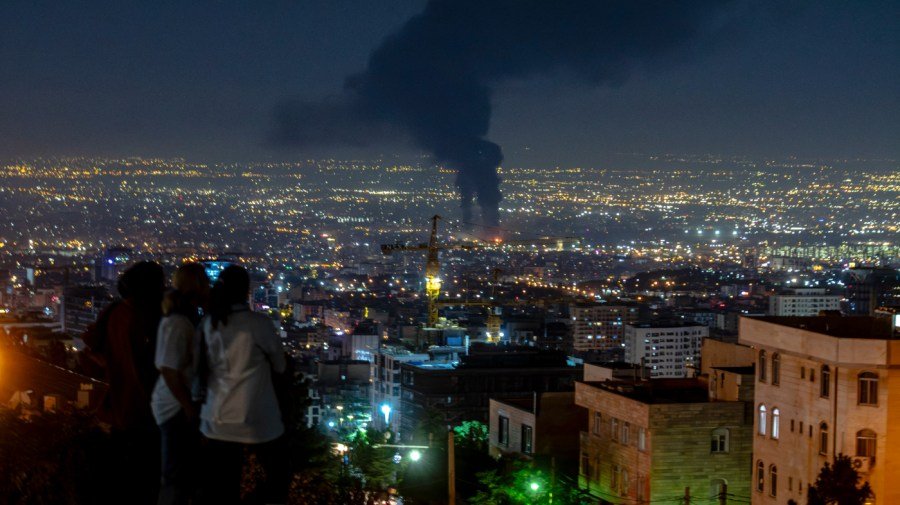
Since its establishment in 1948, Israel has embraced the David and Goliath story as a defining myth, portraying itself as a tiny nation triumphing despite overwhelming odds against a powerful coalition of Arab states.
While that claim had considerable truth for the first few decades of the country’s existence, it has long since ceased to accurately describe the balance of power in the Middle East. Israel’s attack on Iran reveals its ability to hit any of its regional adversaries with overwhelming force, even without direct U.S. assistance.
When Israel was established, it did not look like the country would survive, let alone become a major power. No sooner did it declare independence than a coalition of five Arab states attacked it, determined to “throw the Jews into the sea.”
Tenacious defense combined with the failure of the invaders to coordinate their attacks saved the newborn state from being strangled in the cradle.
Over the next decade, the Israel Defense Forces became a formidable military, but they were still outmatched by the combined strength of the surrounding states. Only with the help of France and Britain could Israel occupy the Sinai in 1956, and even then, the United States forced it to withdraw during the Suez Crisis.
Then came the 1967 Six-Day War. To the shock of most observers, the IDF drove the Egyptians from Sinai, captured the Golan from Syria, and took the West Bank from Jordan.
Israel now seemed to be the dominant player in the region, but victory bred complacency.
On Yom Kippur 1973, an Egyptian Army rebuilt with Soviet aid broke through Israeli defenses along the Suez Canal while Syrian troops overran the lightly defended Golan. With its forces running low on munitions, the IDF was in serious trouble, but President Richard Nixon saved the day with a massive influx of military aid that allowed the Israelis to recoup the situation.
The Yom Kippur War marked the last time Israel faced an existential threat from an Arab coalition. Over the ensuing decades, Israel emerged as the preeminent military power in the Middle East.
Its transition from beleaguered state to regional hegemon depended on three factors.
First, Israel acquired nuclear weapons, probably beginning in 1966-67. Although it will not confirm their existence, the IDF today is believed to have 90 nuclear warheads.
With its Jericho ballistic missiles, F-15 and F-35 aircraft (supplied by the United States), and Dolphin II submarines, Israel can hit targets anywhere in the Middle East. That reality serves as a powerful deterrent for anyone contemplating attacking it, since no other nation in the region has nuclear weapons.
The second factor contributing to Israel’s rise to military hegemony was its systematic dismantling of the Arab alliance against it. It reached a peace accord with Egypt in 1979. In 1988, Jordan renounced its claim to the West Bank and signed a peace treaty with Israel in 1994.
These agreements eliminated the threat of another war with an Arab coalition. They also made it easier for Israel to plant settlements in the occupied territories captured during the Six-Day War.
U.S. support was the third factor contributing to Israel’s rise to regional dominance.
For the first decade and a half of Israel’s existence, the U.S. provided it virtually no military and very little economic aid. Following the Six-Day War and especially after the Yom Kippur War, however, military aid in the form of grants and loans increased dramatically, averaging $3-4 billion annually and spiking to $17.9 billion during the year following the Oct. 7, 2023, attacks.
Since 1948, U.S. aid to Israel has totaled $130 billion ($310 billion adjusted for inflation).
The IDF has received some of the U.S. military’s most advanced equipment, including the F-35 joint-strike fighter, giving it a decisive qualitative edge over any potential adversary. The ease with which it penetrates Iranian air defenses reveals its technological superiority.
U.S. support for Israel has had many positive effects, but also some negative consequences. It has given the country a formidable war machine capable of resisting attacks by any state or alliance in the Middle East. It has also contributed to regional stability.
Nixon’s intervention may have saved Israel in 1973. Jimmy Carter made the Camp David Accords that led to the peace treaty with Egypt possible, and Bill Clinton facilitated the accord with Jordan.
However, the same aid has relieved Israel of the “guns vs. butter” debate over how much to spend on defense and how much on domestic services.
Because of U.S. subsidies, Israelis can have both a large military and generous social welfare benefits, including universal healthcare and heavily subsidized college tuition, approximately $3,000 per year for public institutions, benefits Americans do not enjoy.
U.S. aid has also emboldened Israel to defy international law by appropriating territory in the West Bank and the Golan. Gaza may be next.
The U.S. should continue to guarantee Israel’s right to exist, but that guarantee need not mean writing the country an annual blank check. Providing Israel with defensive weapons only and perhaps even signing a defense treaty with it should, along with its nuclear deterrent, prevent any state from threatening it.
U.S. aid should also be contingent on progress toward a resolution of the Palestinian problem, which creates instability throughout the region. The war in Gaza, the attack on Lebanon and the current Iranian conflict stem from that problem.
Until it is solved, lasting peace will never be achieved. Israel and its neighbors will live in a state of perpetual tension punctuated by periodic outbursts of violence.
As it stands, Israel has two options. It could forcibly expel the entire Palestinian population of the West Bank and Gaza, which hardly seems possible since no other country will take them. Or it can reach a two-state solution, which seems like the only viable means of achieving lasting peace.
As it has done in the past, the United States could play a major role in that peace process.
Tom Mockaitis is a professor of history at DePaul University and the author of “Conventional and Unconventional War: A History of Modern Conflict.”






